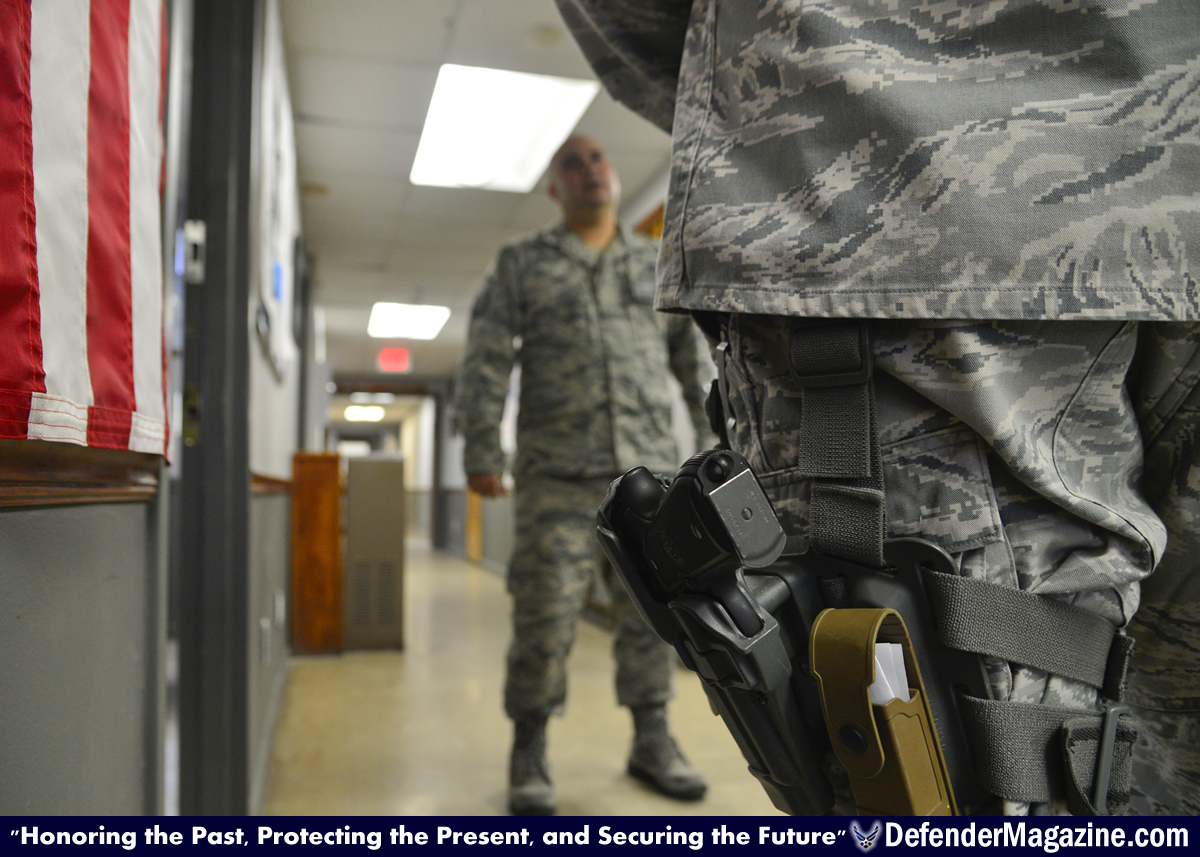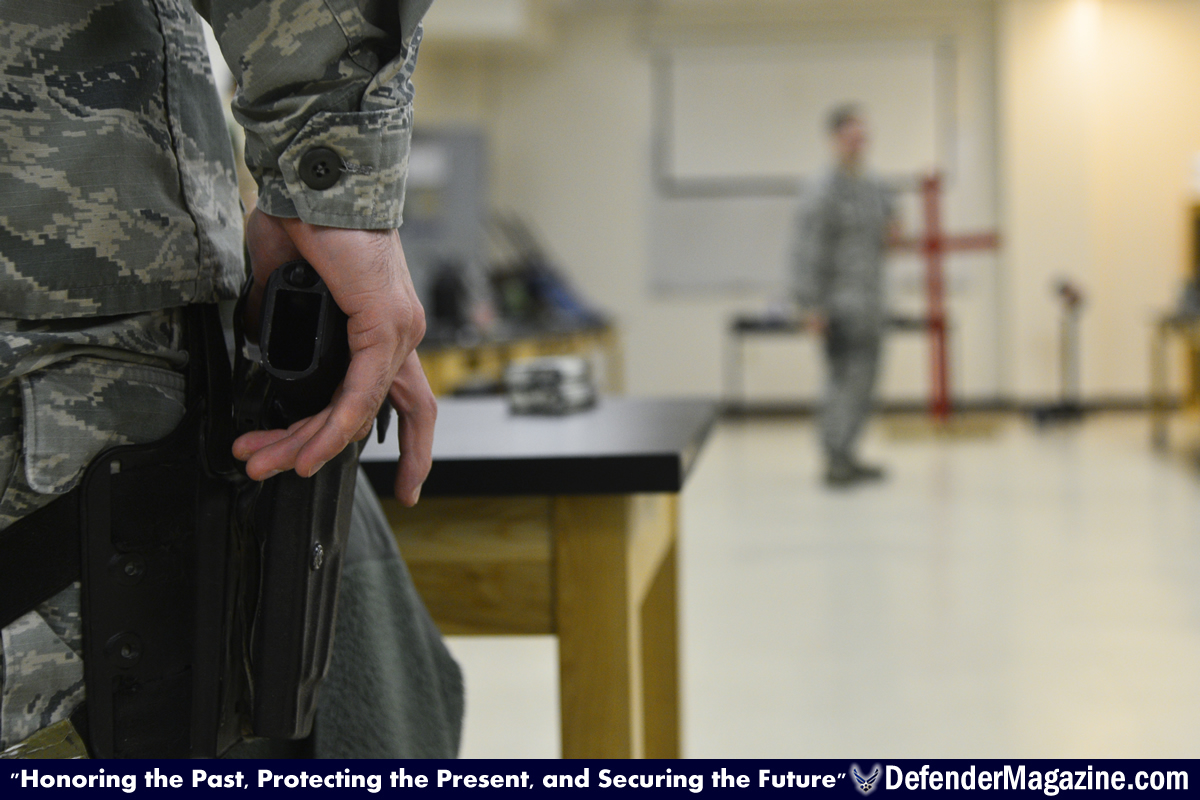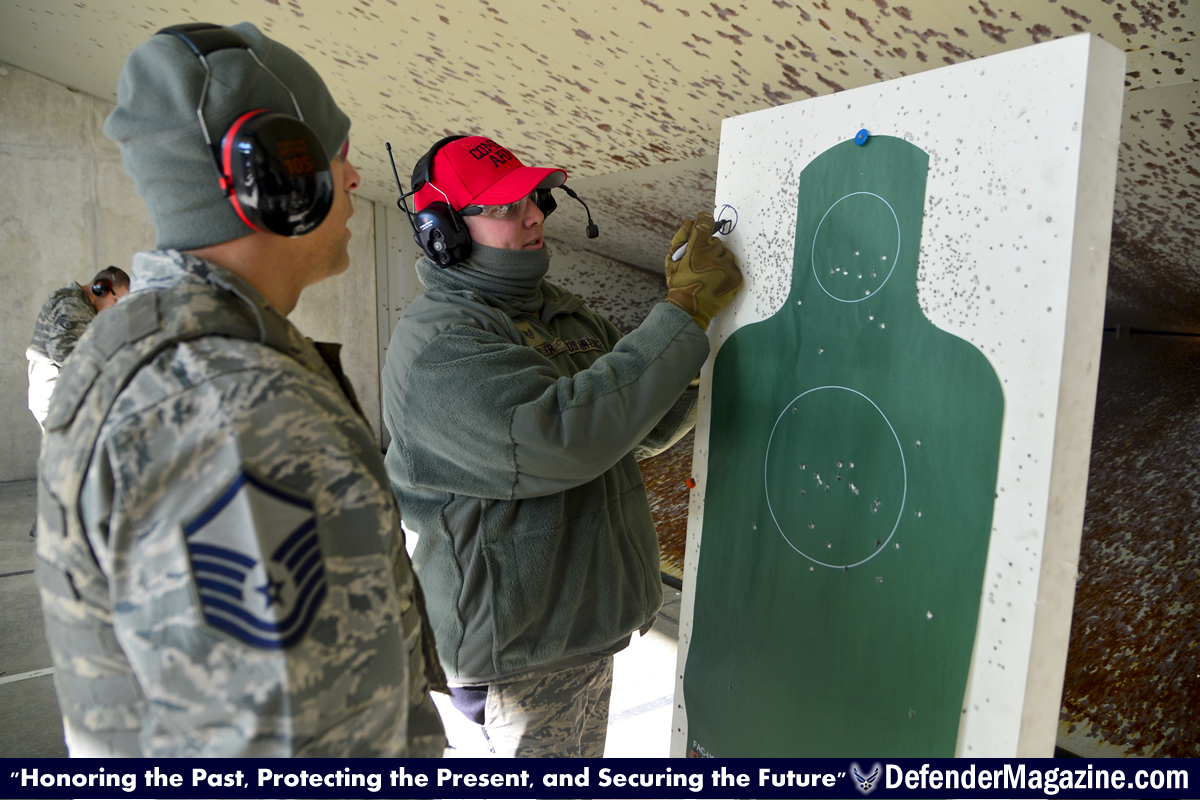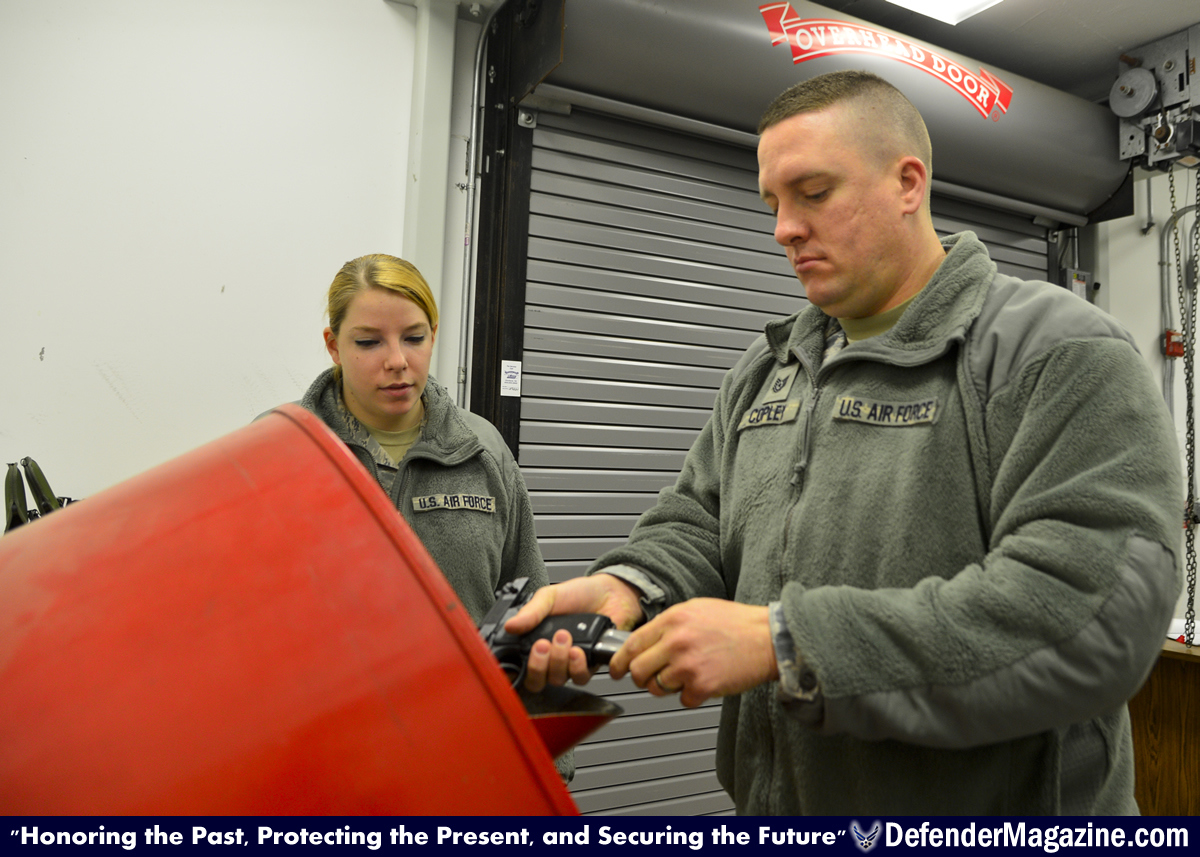
2/1/2016 – DOVER AIR FORCE BASE, Del. — As Team Dover continues to deliver airlift cargo to warfighters downrange and humanitarian relief supplies across the world, it has taken additional security measures to ensure the safety of its own Airmen and their families here at home.
With the recent implementation of Eagle Shield, a combined initiative of selective arming programs, the Unit Marshal Program, or UMP, has officially begun at Dover AFB, Delaware. The UMP is a unit commander’s program where they select Airmen to carry an M9 pistol during the duty day within their work centers.
“The main purpose of this program is to enable a capable body and put a weapon in the building so that we have an armed individual on the inside in the event something does happen,” said Staff Sgt. John Broughal, 436th Security Forces Squadron unit training manager. “The focus of these marshals is to lockdown, secure and save as many lives as possible.”
Tech. Sgt. Matt Copley, 436th Logistics Readiness Squadron fuels service center NCO in charge and unit marshal, speaks to Master Sgt. Patrick Carr, 436th LRS fuels information service center section chief, Feb. 1, 2016, at Dover Air Force, Del. Copley completed the first Unit Marshal Program training course at Dover AFB and is now authorized to carry a M9 pistol at his work center during duty hours. (U.S. Air Force photo/Senior Airman William Johnson)
The 436th SFS trained and educated unit commanders about the UMP and what benefits it could provide to their units. Once commanders agreed to participate in the program, they appointed a Marshal Program Monitor. The program monitor is in charge of notifying the base defense operations center of when and where unit marshals will be working within their unit, ensuring they are always accounted for. The program monitor is also in charge of notifying security forces if there are any changes in the Airman’s ability to fulfil the obligations of a unit marshal. Then commanders selected mature and capable Airmen for the program. Finally, these selectees were vetted by the 436th SFS to look for any disqualifying factors.
Airmen from the 436th Logistics Readiness Squadron and the 436th Medical Group were selected to participate in the first UMP training course. Training included use of force, weapon fundamentals, defensive shooting, active shooter response and actions on combat.
Once the unit marshals were qualified on the M9, they moved on to advance skills training on how to shoot with an elevated heart rate and a variety of different shooting positions. The unit marshals also conducted live fire training drills with simunition rounds in ‘shoot’ or ‘don’t shoot’ scenarios and in a variety of active shooter and disgruntled worker exercises.
“The training was outstanding and the instructors did a great job,” said Tech. Sgt. Matt Copley, 436th LRS fuels service center NCO in charge and unit marshal. “The classroom portion was great, you can hear it, you can see it and you can shoot your weapon. However, what we realized during the simunitions training is how real it was and the fact that you are actually being fired at. Sometimes the way you thought you were going to react wasn’t the way you did once sim-rounds started moving down range.”
The training was originally slated for 40 hours, but because a unit marshal’s responsibilities are so vital, the training was extended to more than 60 hours.
“It’s not because any one of them did something wrong, it’s just that we gave them so much information, and we thought it would benefit them exponentially if we gave them three more working days of training,” said Staff Sgt. Joshua Botto, 436th SFS trainer. “This ensures that we are arming qualified and knowledgeable people with a firearm.”
Lt. Col. Dana Metzger, 436th SFS commander, and other senior security forces personnel observed each unit marshal’s final training scenario before they could be certified as meeting the requirements for training. Metzger stressed that even though unit marshals are trained with the use of force and qualified on a M9, they are not trained as law enforcement officers and do not act as first responders, rather they play a defensive role in their work centers.
“We do not want the marshals to run towards danger, however we want them to protect themselves and protect their personnel.” said Metzger. “They are not trained to be police officers that are going to go towards and eliminate the threat. However, if the threat presents itself and they can take that individual or threat out, then they are authorized to do so.”
Much like security forces defenders, unit marshals will be required to attended quarterly training and stay qualified on the M9. Furthermore, Broughal and other security forces trainers will check in on unit marshals in their work centers at least once a month.
“At any given time, as trainers, we are going to go over to the marshals and do spot checks on them and see how they are functioning within their work centers,” said Broughal. “We also want to see if their co-workers know what to do in a lock down or emergency situation.”
Unit marshals will be easily identifiable within their units. They are required to wear a bright reflective sash that says, ‘Security’ while they are armed with their M9 sidearm. However, in the near future they will transition from the sash to arm brassards.
“Whenever they are armed up we want them to be highly visible to their people,” said Metzger. “That way if there is an incident, those people know to run to the unit marshal and get behind him or her or get out of the building and listen to what they have instructed them to do.”
The 436th SFS also wants the marshals to be highly visible because they are aware as the program rolls out, it might be a shock to some people to see Airmen who are not cops armed with a firearm on base.
“This is a whole different milestone and a new way of thinking, it’s going to be a real eye opener,” said Broughal. “It will definitely take time for other work centers to get use to and people might not be comfortable with it at first, but once they see the overall big picture and it gets pushed Air Force wide, I think they will become more accepting of the program and even like it.”
Even though these Airmen are the first individuals to complete the training course and be certified as unit marshals at Dover AFB, other Air Force bases are already taking notice and asking for assistance with their own UMPs.
“We already have other bases asking for our training plans, lesson plans, after action reports and our lessons learned because they want to implement this program as well,” said Metzger. “That’s the great part about all of this. We are now helping other bases establish a program that I honestly think will save lives.”
by Senior Airman William Johnson
436th Airlift Wing Public Affairs
Team Dover Airmen qualify on M9 pistols while training to be certified unit marshals Jan. 6, 2016, at the Combat Arms Training and Maintenance facility on Dover Air Force Base, Del. Unit marshals went through more than 60 hours of training in use of force, weapon fundamentals, defensive shooting, active shooter response and actions on combat (U.S. Air Force photo/Senior Airman William Johnson)
Staff Sgt. Eliezer Ribeiro, 436thLogistics Readiness Squadron quality assurance evaluator, practices drawing his M9 pistol during a weapons fundamentals training course while training to become a unit marshal Jan. 6, 2016, at the Combat Arms Training and Maintenance facility on Dover Air Force Base, Del. unit marshals will have the option to carry from a drop down leg holster or hip holster. (U.S. Air Force photo/Senior Airman William Johnson)
Staff Sgt. Rhonda Russell, 436th Medical Group pharmacy technician, qualifies on aM9 pistol Jan. 6, 2016, at the Combat Arms Training and Maintenance facility on Dover Air Force Base, Del. Russell also shot an advance pistol course to be certified as a unit marshal. (U.S. Air Force photo/Senior Airman William Johnson)
Staff Sgt. Bryan Miller, 436th Security Forces Squadron trainer, draws a sight alignment picture for Master Sgt. David Loera, 436th Logistics Readiness Squadron installation readiness deployment superintendent, during a M9 qualification course Jan. 6, 2016, at the Combat Arms Training and Maintenance facility on Dover Air Force Base, Del. Miller completed more than 60 hours of training to become one of the first certified unit marshals at Dover AFB. (U.S. Air Force photo/Senior Airman William Johnson)
Staff Sgt. Andrew Nadeau, 436thSecurity Forces Squadron combat arms instructor, teaches a weapons fundamentals training course to Airmen Jan. 6, 2016, at the Combat Arms Training and Maintenance facility on Dover Air Force Base, Del. Airmen selected to be unit marshals attended more than 60 hours of training that included classroom exercises and live fire scenarios. (U.S. Air Force photo/Senior Airman William Johnson)
Tech. Sgt. Matt Copley, 436th Logistics Readiness Squadron fuels service center NCO in charge and unit marshal, loads his M9 pistol prior to the start of the duty day Feb. 1, 2016, at Dover Air Force Base, Del. Copley completed the first Unit Marshal Program training class at Dover AFB and is authorized to carry a M9 at his work center during duty hours. (U.S. Air Force photo/Senior Airman William Johnson)





